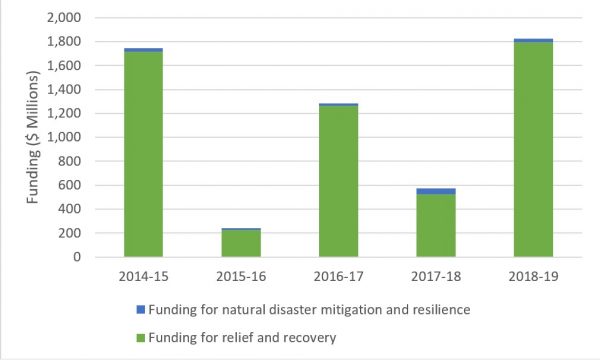Since September, multiple significant bushfires in New South Wales and Queensland have burnt across 2.2 million hectares and destroyed over 700 homes. The resultant public debate has focused on the role of climate change in increasingly long and intense fire seasons. It has also raised questions about the level of funding allocated to response agencies, for measures such as water bombing and volunteer support.
These debates are important because the costs of responding to bushfires is escalating rapidly. More effective means of putting fires out is part of the solution. However, climate change, population growth and increasing urbanisation on the fringes of our cities is increasing bushfire risk. Without an increased focus on mitigation, the costs of responding and recovering from bushfires are likely to become unsustainable for government, communities and businesses.
Risk mitigation can reduce the costs of fires by reducing the likelihood of bushfires starting in the first place, and by reducing the consequences or impacts of bushfires when they do occur. Bushfire risk mitigation activities can include direct physical interventions such as land use changes, infrastructure, planning and development. Mitigation activities can also include community engagement actions such as building awareness and understanding of risks, and development of preparedness programs and plans, which help minimise a bushfires impact and help communities build resilience and recover more effectively.
Research undertaken by the Australian Business Roundtable for Disaster Resilience and Safer Communities in 2013 found, for particular events, that for every dollar spent on disaster mitigation between three and eight dollars is saved in terms of damages avoided. Whilst these benefits are significant, there is a high level of uncertainty of the value of specific mitigation actions, for bushfires or other events, due to a lack of data and analysis of mitigation activities.
While state governments have primary responsibility for managing natural disasters, payments to states by the Australian Government are an important source of funding. Currently, funding for natural disaster recovery are substantially higher than funding for mitigation as shown in Figure 1.
Figure 1: 5-year breakdown of federal government spending on relief and recovery compared to mitigation efforts

Note: these figures exclude provisions made specifically for fire services. Data is taken from Commonwealth Final Budget Outcomes (2014/15-2018/19).
Mitigation spending by the federal government in the past five years has averaged under $30 million, despite calls from the Productivity Commission and the Australian Business Roundtable to increase resilience spending to states to $200-250 million. Such disparity between mitigation and response and recovery funding is also apparent across the globe.
Why is this the case? One reason is likely to be the difficulty of measuring and communicating the benefits of mitigation disasters compared with responses. For example:
- response and recovery actions have direct and immediate benefits that are easily identifiable and communicated
- the return on investment for mitigation actions is not usually immediate or certain
- the benefits of some mitigation actions can be difficult to measure.
Allocating funding to avoid long term and uncertain future costs is not the simplest or most immediately attractive investment to communicate. Therefore decision-makers can favour investing in more immediate and visible, but less effective, measures.
How can mitigation spending be made more appealing to decision makers?
A combined understanding of the full environmental, economic and social values at risk from bushfires is required to fully prioritise and understand the potential costs and benefits of mitigation and response options. Bushfire risk data related to expected loss of life and building damage is of a high standard due to sophisticated physical models of the likely ignition and spread of fires under different conditions. However, these models do not account for the full range of economic, social and environmental costs associated both with bushfires and with bushfire management options.
Integrating the economic and scientific models to fully account for all risks and the costs of both mitigation and response actions will allow for more targeted management of risks within the constraints of available funding. This will lead to better decision-making processes, for example reducing overinvestment in expensive response equipment which may only marginally reduce the effects of bushfires, and increasing investment in activities such as community preparedness which can have significant benefits in reducing lives lost and faster recovery.
Better understanding of the full costs and benefits of all bushfire mitigation and response activities is vital to optimise the use of scare resources in the face of growing bushfire risk. Improved evidence on the efficacy of mitigation actions in terms of economic, social and environmental benefits will help to make these options more appealing to decision makers. It will also allow the communication of resource allocations options and decisions more transparent and allow an open and transparent debate regarding the trade-off made across funding priorities.
The effects of climate change and population growth are driving increasing bushfire risks across the country. As fire seasons get longer, and the costs of responding to bushfires increase, it may become impossible, both physically and financially, to manage bushfires under the current response-focused approach. It will therefore become increasingly important to target funding on the most cost-effective activities that can most materially reduce bushfire risk, and improve the welfare of the whole community. This requires a more sophisticated approach to how we allocate resources to bushfire management across mitigation, response and recovery.

